Solar eclipse of April 7, 1978
A partial solar eclipse occurred on April 7, 1978. A solar eclipse occurs when the Moon passes between Earth and the Sun, thereby totally or partly obscuring the image of the Sun for a viewer on Earth. A partial solar eclipse occurs in the polar regions of the Earth when the center of the Moon's shadow misses the Earth.
| Solar eclipse of April 7, 1978 | |
|---|---|
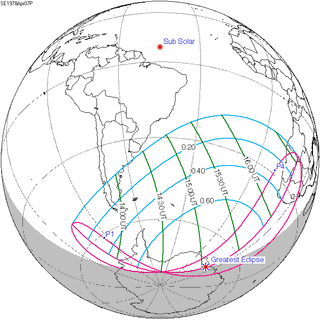 Map | |
| Type of eclipse | |
| Nature | Partial |
| Gamma | -1.1081 |
| Magnitude | 0.7883 |
| Maximum eclipse | |
| Coordinates | 71.9°S 23.3°E |
| Times (UTC) | |
| Greatest eclipse | 15:03:47 |
| References | |
| Saros | 148 (19 of 75) |
| Catalog # (SE5000) | 9460 |
Related eclipses
Solar eclipses of 1975–1978
There were 8 solar eclipses (at 6 month intervals) between May 11, 1975 and October 2, 1978.
| Solar eclipse series sets from 1975–1978 | ||||||
|---|---|---|---|---|---|---|
| Descending node | Ascending node | |||||
| Saros | Map | Gamma | Saros | Map | Gamma | |
| 118 | 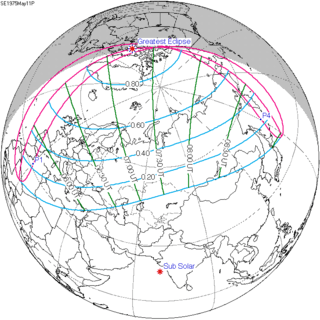 1975 May 11 Partial | 1.06472 | 123 | 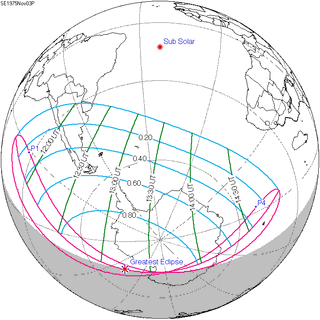 1975 November 3 Partial | -1.02475 | |
| 128 | 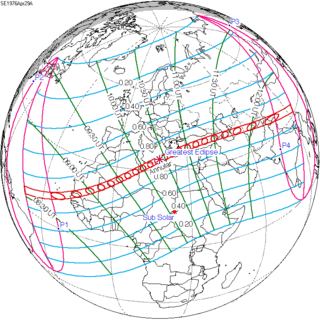 1976 April 29 Annular | 0.33783 | 133 | 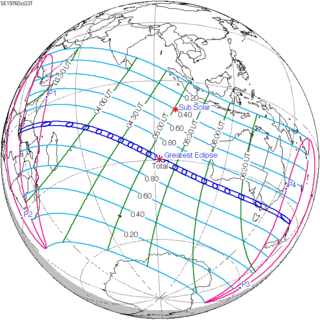 1976 October 23 Total | -0.32699 | |
| 138 |  1977 April 18 Annular | -0.39903 | 143 | 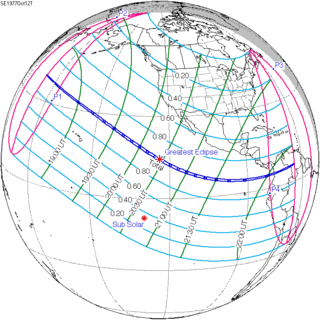 1977 October 12 Total | 0.38363 | |
| 148 |  1978 April 7 Partial | -1.10812 | 153 |  1978 October 2 Partial | 1.16164 | |
Metonic series
The metonic series repeats eclipses every 19 years (6939.69 days), lasting about 5 cycles. Eclipses occur in nearly the same calendar date. In addition, the octon subseries repeats 1/5 of that or every 3.8 years (1387.94 days).
| 22 eclipse events, progressing from north to south between April 8, 1902 and August 31, 1989: | ||||
|---|---|---|---|---|
| April 7–8 | January 24–25 | November 12 | August 31-September 1 | June 19–20 |
| 108 | 114 | 116 | ||
 April 8, 1902 |
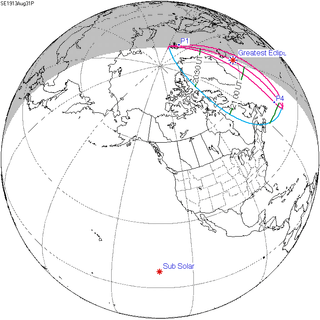 August 31, 1913 |
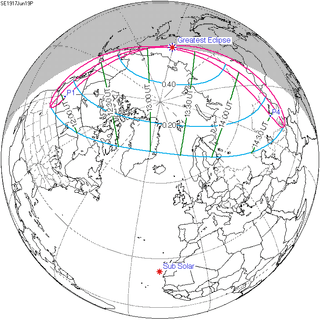 June 19, 1917 | ||
| 118 | 120 | 122 | 124 | 126 |
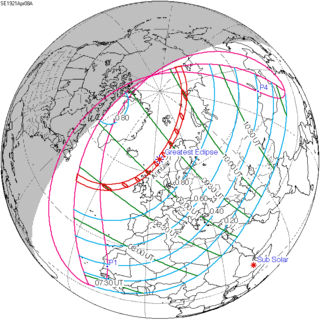 April 8, 1921 |
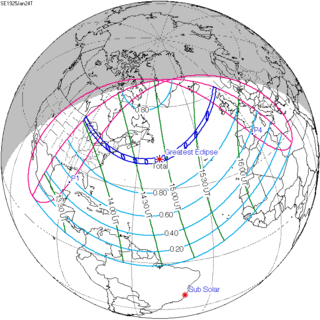 January 24, 1925 |
 November 12, 1928 |
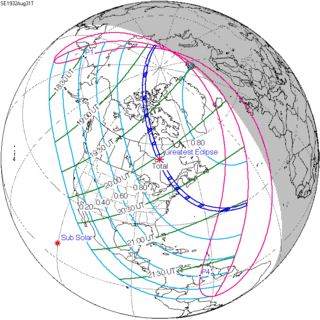 August 31, 1932 |
 June 19, 1936 |
| 128 | 130 | 132 | 134 | 136 |
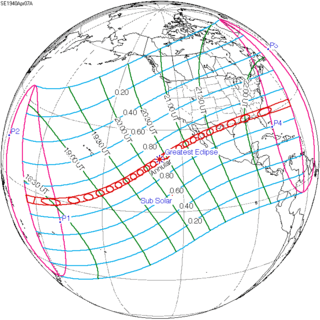 April 7, 1940 |
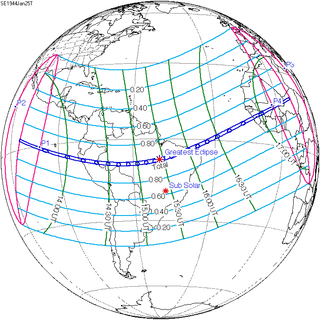 January 25, 1944 |
 November 12, 1947 |
 September 1, 1951 |
 June 20, 1955 |
| 138 | 140 | 142 | 144 | 146 |
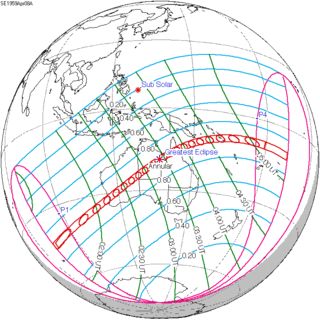 April 8, 1959 |
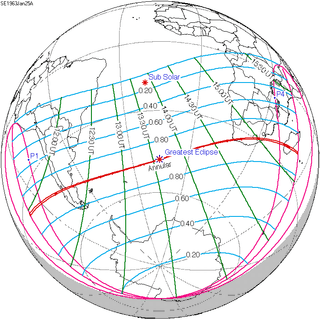 January 25, 1963 |
 November 12, 1966 |
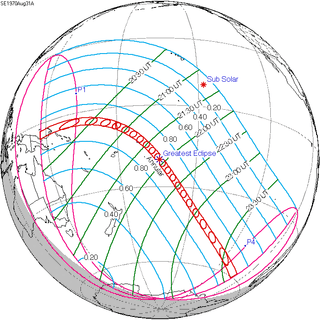 August 31, 1970 |
 June 20, 1974 |
| 148 | 150 | 152 | 154 | |
 April 7, 1978 |
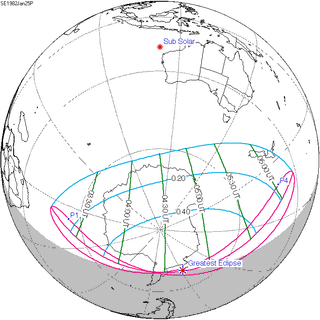 January 25, 1982 |
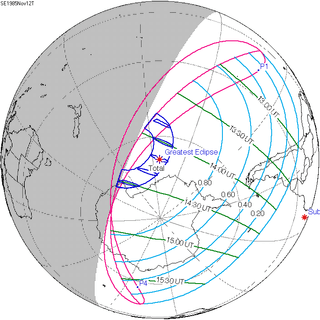 November 12, 1985 |
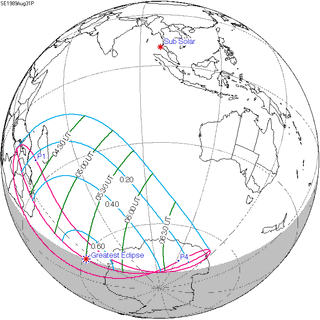 August 31, 1989 | |
gollark: If UK health authorities had actually called for stopping COVID-19 vaccine use, then yes, this would be worrying.
gollark: Because it became a political issue currently.
gollark: That still doesn't fix the data apparently being bad and open-submission.
gollark: And you shouldn't just go for the worst-case scenario (conveniently one making your preferred point best) when assuming things; you should find the most realistic one, and/or provide a range.
gollark: The US government has frequently been useless and incompetent at pandemic handling (halting the J&J vaccine and initially claiming masks didn't work are the two obvious things I can think of), but that doesn't mean that everything they say is wrong, or that belief in things that the government says is necessarily just because the government says it.
References
External links
- Earth visibility chart and eclipse statistics Eclipse Predictions by Fred Espenak, NASA/GSFC
This article is issued from Wikipedia. The text is licensed under Creative Commons - Attribution - Sharealike. Additional terms may apply for the media files.
.jpg)
